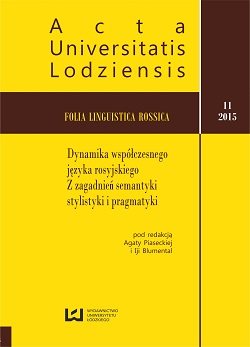Bilingual vernacular
DOI:
https://doi.org/10.18778/1731-8025.11.16Keywords:
bilingual vernacular, verbal, behavioral, associative interferencesAbstract
In this article we discuss qualification of bilingual speech type, which is usually called nonnative speech, pidgin, colloquial speech. It is characterized by deviance, entropy of norm for all levels of language, speech and pragmatics. Verbal, behavioral, associative interferences are explained by the reasons that the bilingual in a second language speech looks for support in his own language, own culture, in his individual cognitive experience. All of the above form a functional type of speech, which I call a bilingual vernacular. It takes its own place in classification of functional types of speech, increasing their paradigm due to nonnative speech implementation. In bilingual vernacular communication a distancing from the norm is explained by the lack of its credibility in native speech. There is a parallelism of bilingual speech functional types: by means of facilitation the native communicative experience is transferred into the second language speech.
References
Девкин В. Д. (1984), О видах нелитературности речи, [в:] Городское просторечие. Проблемы изучения, ред. Е. Земская, Д. Шмелев, Москва, с. 12–21.
Google Scholar
Золотова Г. А., Онипенко Н. К., Сидорова М. Ю. (2004), Коммуникативная грамматика русского языка, Москва.
Google Scholar
Клоков В. Т. (2000), Французский язык в Африке, Саратов.
Google Scholar
Курохтина Т. Н. (2010), Межъязыковая интерференция в условиях близкородственного украинско-русского двуязычия, специальность 10.02.03 – славянские языки, автореферат диссертации на соискание ученой степени кандидата филологических наук, Москва.
Google Scholar
Ларин Б. А. (1977), О лингвистическом изучении города, [в:] Ларин Б. А., История русского языка и общее языкознание. Избранные работы, Москва.
Google Scholar
Поливанов Е. Д. (1968), Фонетика интеллигентского языка, [в:] Поливанов Е. Д., Статьи по общему языкознанию, Москва, с. 225–235.
Google Scholar
Сансызбаева С. К. (2012), Узуальные коннотативные особенности казахско-русских зооморфизмов, «Вестник КарГУ. Серия «Филология», №4 (68), с. 157–162.
Google Scholar
Фуко М., Cлова и вещи, http://lib.ru/CULTURE/FUKO/weshi.txt
Google Scholar
Bernstein B. (1966), Elaborated and restricted codes: an outline, [in:] «Sociological Inquiry», 36, 1966.
Google Scholar
DOI: https://doi.org/10.1111/j.1475-682X.1966.tb00628.x
Downloads
Published
How to Cite
Issue
Section
License

This work is licensed under a Creative Commons Attribution-NonCommercial-NoDerivatives 4.0 International License.









